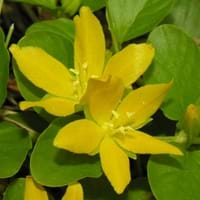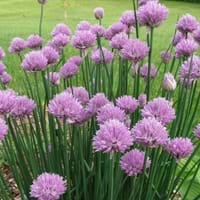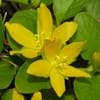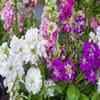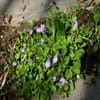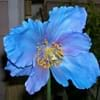Life Span
Perennial
Perennial
Type
Flowering Plants, Perennial
Herbs
Origin
Europe
World/Pandemic, North America, Europe, Asia
Types
creeping jenny
Common chives, Garlic chives, Siberian garlic chives, Giant Siberian chives
Number of Varieties
Not Available
Habitat
Near ponds, River side, Wet ground
Rocky areas
USDA Hardiness Zone
4-8
4-9
Sunset Zone
1a, 1b, 2a, 2b, 3a, 3b, 4, 5, 6, 7, 8, 9, 14, 15, 16, 17, 18, 19, 20, 21, 22, 23, 24
A1, A2, A3, H1, H2, 1a, 1b, 2a, 2b, 3a, 3b, 4, 5, 6, 7, 8, 9, 10, 11, 12, 13, 14, 15, 16, 17, 18, 19, 20, 21, 22, 23, 24
Habit
Spreading
Clump-Forming
Flower Color
Yellow
White, Pink, Lavender
Flower Color Modifier
Bicolor
Not Available
Fruit Color
Not Available
Black
Leaf Color in Spring
Green
Green, Light Green
Leaf Color in Summer
Green
Green
Leaf Color in Fall
Green
Green, Yellow green
Leaf Color in Winter
Light Green
Not Available
Leaf Shape
Ovate
Grass like
Plant Season
Spring, Summer, Fall
Spring, Summer, Fall
Sunlight
Full Sun, Partial Sun, Partial shade, Full Shade
Full Sun, Partial Sun
Type of Soil
Clay, Loam
Loam, Sand
The pH of Soil
Acidic, Neutral
Neutral
Soil Drainage
Average
Well drained
Bloom Time
Late Spring, Early Summer
Late Spring, Early Summer
Tolerances
Drought
Not Available
Where to Plant?
Container, Ground, Pot
Ground, Pot
How to Plant?
Stem Planting
Seedlings, Transplanting
Plant Maintenance
Medium
Medium
Watering Requirements
Requires a lot of watering, Requires regular watering
Requires regular watering, Water every two or three days during warmer months, Water when soil is dry
In Summer
Lots of watering
Lots of watering
In Spring
Moderate
Moderate
In Winter
Average Water
Average Water
Soil pH
Acidic, Neutral
Neutral
Soil Type
Clay, Loam
Loam, Sand
Soil Drainage Capacity
Average
Well drained
Sun Exposure
Full Sun, Partial Sun, Partial shade, Full Shade
Full Sun, Partial Sun
Pruning
Remove damaged leaves, Remove dead branches, Remove dead leaves
Prune in spring, Prune in summer, Prune to stimulate growth, Remove deadheads
Fertilizers
All-Purpose Liquid Fertilizer
All-Purpose Liquid Fertilizer
Pests and Diseases
Pests and diseases free
Bacterial leaf spot, Damping-off, Downy mildew, head rot, Pink Root, Rust, Thripes
Plant Tolerance
Drought
Drought
Flower Petal Number
Single
Single
Fragrant Bark/Stem
No
Yes
Foliage Texture
Medium
Fine
Foliage Sheen
Glossy
Matte
Attracts
Not Available
Not Available
Allergy
Asthma
Asthma, Diarrhea, Itchiness, Pain and fatigue, Skin rash
Aesthetic Uses
Beautification, Bouquets, Used for decorating walls, fences, gates, hedges, etc.
Not Used For Aesthetic Purpose
Beauty Benefits
Not Available
Not Available
Environmental Uses
Provides ground cover
Air purification
Medicinal Uses
Diarrhea
Antioxidants, Bone strength, Improve heart health, Nutrients
Part of Plant Used
Flowers, Leaves
Leaves, Seeds
Other Uses
Used as Ornamental plant
Employed in herbal medicine, Used As Food
Used As Indoor Plant
No
Yes
Used As Outdoor Plant
Yes
Yes
Garden Design
Container, Edging, Groundcover, Hanging Basket, Mixed Border, Water Gardens
Alpine, Cutflower, Edible, Herb / Vegetable, Mixed Border, Rock Garden / Wall
Botanical Name
LYSIMACHIA nummularia 'Goldilocks'
ALLIUM schoenoprasum
Common Name
Creeping jenny, moneywort, herb twopence and twopenny thot
Chives, Cultivated Chives, Garden Chives
In Hindi
Lysimachia Nummularia
Chives
In German
Lysimachia Nummularia
Schnittlauch
In French
Lysimaque nummulaire
Ciboulette
In Spanish
Lysimachia nummularia
Cebollino
In Greek
Λυσιμαχία nummularia
βολβοί φαγώσιμοι
In Portuguese
Lysimachia nummularia
Cebolinha
In Polish
tojeść rozesłana
Szczypiorek
In Latin
Lysimachiam nummularia
Sectivi porri
Phylum
Tracheophyta
Spermatophyta
Class
Magnoliopsida
Liliopsida
Order
Ericales
Asparagales
Family
Primulaceae
Liliaceae
Clade
Angiosperms, Asterids, Eudicots
Angiosperms, Monocots
Tribe
Not Available
Not Available
Subfamily
Not Available
Allioideae
Number of Species
Not Available
Not Available
Importance of Lysimachia Nummularia and Chives
Want to have the most appropriate plant for your garden? You might want to know the importance of Lysimachia Nummularia and Chives. Basically, these two plants vary in many aspects. Compare Lysimachia Nummularia and Chives as they differ in many characteristics such as their life, care, benefits, facts, etc. Every gardener must at least have the slightest clue about the plants he wants to plant in his garden. Compare their benefits, which differ in many ways like facts and uses. The medicinal use of Lysimachia Nummularia is Diarrhea whereas of Chives is Antioxidants, Bone strength, Improve heart health and Nutrients. Lysimachia Nummularia has beauty benefits as follows: Not Available while Chives has beauty benefits as follows: Not Available.
Compare Facts of Lysimachia Nummularia vs Chives
How to choose the best garden plant for your garden depending upon its facts? Here garden plant comparison will help you to solve this query. Compare the facts of Lysimachia Nummularia vs Chives and know which one to choose. As garden plants have benefits and other uses, allergy is also a major drawback of plants for some people. Allergic reactions of Lysimachia Nummularia are Asthma whereas of Chives have Asthma, Diarrhea, Itchiness, Pain and fatigue and Skin rash respectively. Having a fruit bearing plant in your garden can be a plus point of your garden. Lysimachia Nummularia has no showy fruits and Chives has no showy fruits. Also Lysimachia Nummularia is flowering and Chives is flowering. You can compare Lysimachia Nummularia and Chives facts and facts of other plants too.
